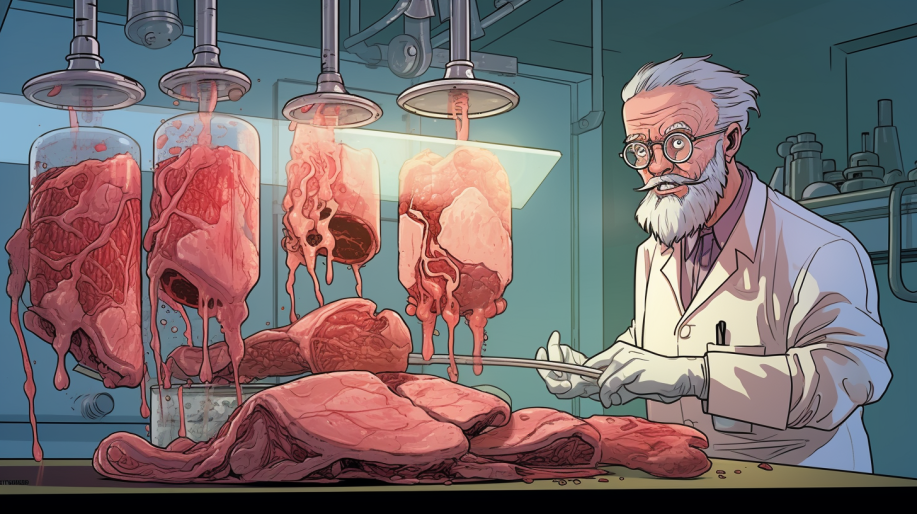Cultured meat, also known as lab-grown meat, could revolutionize the future of food and farming.
But does the science live up to the hype?
Key Facts:
- Cultured meat is real muscle tissue grown from animal cells in a lab, without slaughtering animals.
- It’s not yet commercially available, but several startups are working to bring it to market.
- Advocates claim it’s better for the environment, animal welfare and health than conventional meat.
- Critics argue the benefits are overstated and cultured meat raises new concerns.
- The jury is still out until scaled-up commercial production can be analyzed.
Source: Anim Front 2022
What Exactly is Lab Grown Meat?
Lab grown meat, also called cultured meat, clean meat or in vitro meat, refers to meat produced by culturing animal cells in a growth medium outside of the animal.
It’s not a meat substitute like plant-based burgers.
It’s real animal tissue grown from the cells in a laboratory rather than within an animal’s body.
The basic process is:
- Take a biopsy from a live animal to extract starter cells. This is a small tissue sample similar to a blood draw.
- Isolate stem cells that can differentiate into muscle and fat cells.
- Culture the cells in a nutrient-rich solution to encourage growth and proliferation.
- Stimulate the cells to fuse into muscle fibers and self-organize into meat tissue.
- Harvest the finished product after several weeks when it resembles conventional meat.
This allows meat to be produced without raising and slaughtering animals.
A small sample could theoretically produce massive quantities of meat.
Brief History of Cultured Meat
Cultured meat technology builds on decades of cell biology and tissue engineering research. A few key milestones:
- Early 2000s: NASA funded studies on cultured meat for long space missions.
- 2013: First lab-grown burger patty cooked and tasted publicly in London.
- 2018-2020: Several startups formed to commercialize cultured meat, with significant venture capital investments.
- 2020: Singapore approved the first cultured meat product, chicken nuggets by Eat Just.
No cultured meat products are yet approved for sale in the U.S. or Europe.
But it’s a rapidly evolving field that could reshape the meat industry.
Potential Benefits of Cultured Meat
Advocates believe cultured meat has several advantages over conventional meat:
Sustainability
Some analyses show substantially lower environmental impacts.
Producing cultured meat may generate:
- 78-96% lower greenhouse gas emissions
- 82-96% less water pollution
- 78-95% lower water use
- 99% lower land use
With conventional meat production estimated to account for 14.5% of global greenhouse emissions, cultured meat could be a game changer for combating climate change.
However, other analyses are more conservative.
Better data is needed from commercial-scale production.
Ethics & Factory Farming
Cultured meat would eliminate the perceived cruelty and suffering involved in industrial animal agriculture.
Animals would no longer need to be raised in crowded CAFOs (concentrated animal feeding operations) or slaughtered for food production.
However, animals would still be needed for starter cells.
Small tissue samples could be collected humanely, but regular biopsies raise welfare concerns.
Using immortal cell lines would be truly slaughter-free, but this technology requires more research.
Healthier & Safer

Cultured meat is produced in a controlled, sterile environment.
Supporters believe this results in a cleaner final product:
- Lower risk of contamination from fecal pathogens like E. coli and Salmonella
- No antibiotic residues which contribute to superbug resistance
- Potentially more vitamins and healthier fats if engineered that way
Detractors argue the health claims are overblown given the lack of human consumption data.
The nutrients added to the growth medium may not have the same bioavailability or benefits as nutrients naturally occurring in meat.
Consumer Acceptance
Early market research indicates broad openness to trying cultured meat, especially among younger generations.
Surveys show:
- 2/3 of U.S. consumers would be willing to try cultured meat
- Nearly half of U.S. consumers are interested in eating cultured meat regularly
However, cost and “naturalness” concerns could hamper widespread adoption.
The high-tech, lab-made origins may put off some consumers despite identical cell composition.
Potential Concerns About Cultured Meat
While optimism abounds in the cultured meat industry, experts urge caution until scalable commercial production can be independently analyzed.
Some top concerns include:
Requires Animal Inputs
The most efficient growth mediums for cultured meat use fetal bovine serum from cow fetuses as a nutrient source.
This still necessitates animal slaughter.
Large companies have invested in developing animal-free mediums, but these alternatives haven’t yet achieved cost-effective results.
Unknown Environmental Impact
While some researchers predict dramatic reductions in land, water and emissions, others point out the unknowns:
- No public data from industrial-scale facilities, only academic estimates
- Electricity sources for mass production could outweigh cuts in methane emissions
- Warming impacts of methane vs. CO2 are complex; reductions may be less than anticipated
Well-to-wheel environmental lifecycle assessments of commercial operations will provide clarity.
Food Safety Unproven
As a novel food production process, regulatory approval will require rigorous safety testing.
Possible concerns include:
- Pathogen contamination risk in bioreactor environments
- Ingredients used to stimulate growth of muscle cells
- Impacts on cell biology from genetic modifications
- Lack of natural microbial exposure to develop immunity
Until cultured meat hits the market, promise of safer meat remains theoretical.
Nutrition Content vs. Conventional Meat
Factors like myoglobin levels, fatty acid profiles, micronutrient content and bioavailability could differ substantially from farm-raised meat products.
Engineered additions to the growth medium could enhance nutrition.
But the health benefits compared to conventional meat are debatable.
Texture, Color, Flavor
Cultured meat today lacks many qualities of meat from the butcher:
- Texture is softer without exercise and physical stimulation
- Color is paler without oxygenation from blood
- Flavor is blander without natural fat marbling
Post-processing additions like beet juice or saffron to mimic sensory properties of conventional meat indicate there’s progress to be made.
Cost-Ineffective (Currently)
The first cultured meat burger in 2013 cost over $300,000 to produce.
Recent estimates put the cost between $100-200 per pound.
Until production costs drop dramatically, cultured meat won’t be economically viable for regular consumption.
Consolidates Power in Big Agriculture
Well-funded startups and major meat corporations dominate cultured meat development, raising concerns about consolidation of food production.
Local, small-scale farmers would be pushed out by Silicon Valley-style food ventures.
Cultural traditions of animal agriculture could decline.
Is Lab Grown Meat the Future of Food?
Many see cultured meat as the inevitable path forward to sustainably feed the world’s growing population.
But uncertainty remains around scaled-up production.
Cultured meat is unlikely to fully replace conventional meat anytime soon.
Cost, regulatory approval and consumer acceptance are significant hurdles.
Blending cultured and farm-raised meats may offer an interim solution to improve sustainability.
Continued improvement of animal welfare practices can also help meet ethical responsibilities.
Public sentiment favors moderation in meat consumption over outright elimination.
Transitioning toward healthier, greener diets with a mix of protein options appeals to more consumers than cultured meat purism.
The bottom line is we need transparent data from commercial cultured meat operations before proclaiming it the solution to our climate, food system and ethics woes.
Responsible science communication means acknowledging both the tremendous potential and the challenges that remain.
References
- Study: Is cultured meat a viable alternative to slaughtering animals and a good comprise between animal welfare and human expectations?
- Authors: Sghaier Chriki et al. (2022)







